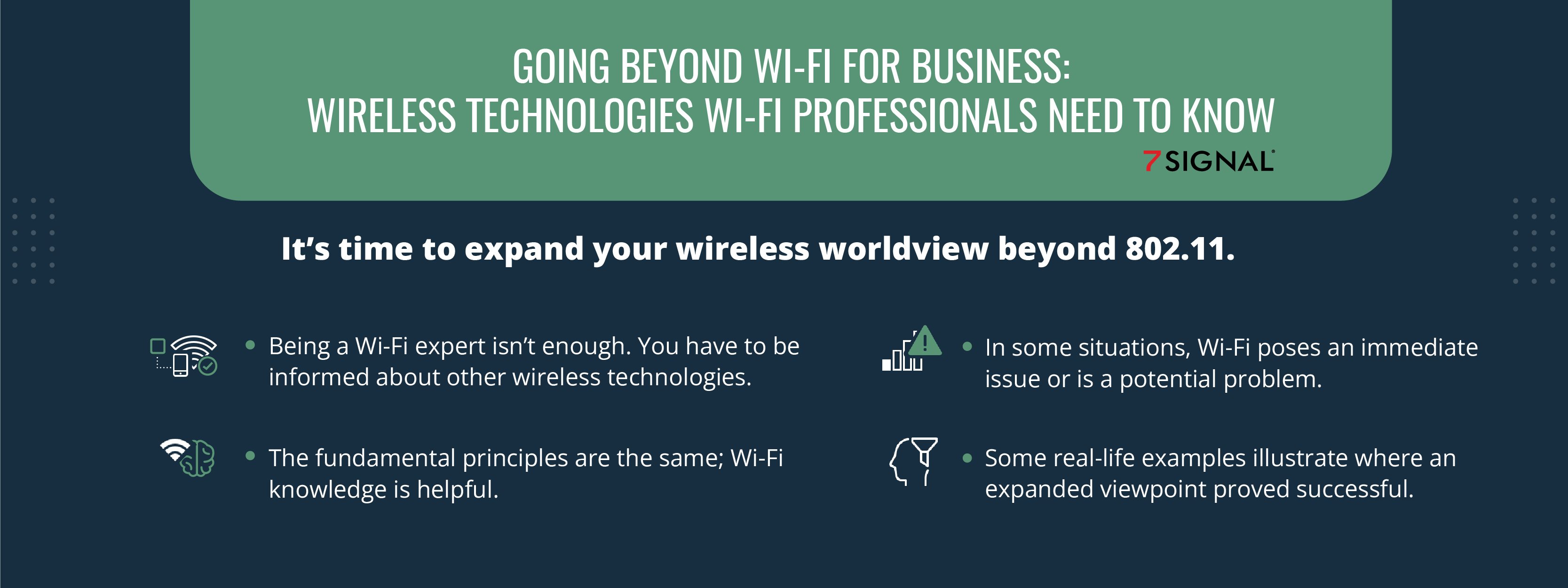
Blog
Going Beyond Wi-Fi for Business: Wireless Technologies Wi-Fi Professionals Need to Know
It’s time to expand your wireless worldview beyond 802.11.

While 802.11 has dominated, the wireless ecosystem is changing fast, and for those who want to develop professionally and provide their business clients with the best, it’s time to shift perspective.
It’s not enough to be Wi-Fi savvy. There are situations when Wi-Fi is not preferred, but sometimes people want to use it because it exists in an environment. It’s important to know about better options and how to suggest them when necessary, even if you don’t expect to become an expert in the alternatives. The goal is to understand what is likely the best fit for a given situation.
Consider fundamental principles and current methodologies. Regardless of the technology in question, problems such as interference are likely, but what you’ve learned about Wi-Fi can be applied to troubleshoot those issues. New technologies evolve, but old principles and methodologies still prevail. Wi-Fi knowledge will never be obsolete.
This article covers real-world examples provided by Wireless Network Architect Lee Badman from this webinar, Wireless Technologies Wi-Fi Professionals Need to Know.
Wireless technologies and a townhouse complex
In this example, Lee was approached to install sensors in a townhouse complex to monitor a smart building system, measuring power consumption, temperature, humidity, and overall building efficiency before and after system installation. The plan was to collect baseline measurements, rehabilitate the building, and then compare the results to gauge the improvements. The initial wireless technology of choice was Wi-Fi. However, several issues arose with this approach, including:
- A limited number of wall outlets make it challenging to install the sensors.
- Gaining access to individual Wi-Fi networks and passwords.
- Troubleshooting and maintaining the system would require entering the apartments and examining Wi-Fi networks.
Using Wi-Fi in this situation would not yield positive results.
LoRaWAN, a cloud-based medium access control (MAC) layer protocol, was a much better option. LoRaWAN acts as a network layer protocol to manage communication between LPWAN gateways and end-node devices. It serves as a routing protocol maintained by the LoRa Alliance.
In the townhouse complex, the gateway was placed in a common area with an internet connection; the sensors run on battery power and penetrate walls because it’s a low-frequency, low-data application. This approach eliminated the need to disturb the residents and bypassed the issues associated with using Wi-Fi.
This example illustrates the importance of knowing about alternative technologies and how they can lead to more effective and efficient solutions in real-world applications.
Wireless connectivity for a large public venue
Wireless networks in a stadium or a large public venue can be challenging. During an event, there could be 60,000 people on hand – vendors trying to conduct business, people using their hotspots, the production crew requiring the network, staff operating wireless intercom systems, etc.
The load on the wireless network is pushed beyond its limits, and even the mobile network is loaded down with people photographing and posting their shots on social media. In this case, a more compatible option than Wi-Fi would be Citizens Broadband Radio Service (CBRS/Private 4G/5G), a private, two-way, short-distance voice communications service for general public personal or business activities.
Urban environments and wireless technologies
Relying solely on Wi-Fi in a busy city might present an issue, especially in high-density areas. Using inexpensive, 2.4 GHz or 5GHz bridges can’t be expected to work well, especially when connecting two buildings in a busy city. There’s too much interference and inconsistency. It might work today but might not tomorrow because of population density. This and 802.11, or unlicensed bridges, are not enough.
Wi-Fi tends to be the targeted solution because it’s easy and it’s a known quantity. It’s readily available and commonly used for everyday devices. However, if people require connectivity for learning, training, or doing business, where the video and audio content are critical, another solution is preferred.
The goal is to have good content transmission for anything beyond entertainment. WiGig, based on IEEE 802.11, is a possibility. WiGig allows Wi-Fi devices access to an uncongested 60 GHz frequency band with wide channels to transmit data efficiently at multi-gigabit-per- second speeds.
A few WiGig options are available, though they are not very common. WiGig will provide more success than Wi-Fi when multiple users are in one room.
Even using proprietary technologies may disappoint, but if you are sufficiently informed about other wireless technologies, you can locate an optimum solution.
Just because it can go on Wi-Fi doesn’t mean it should, and the more wireless technologies you’re aware of the better. The goal is connectivity, not solving one problem while creating another. Think beyond the wireless 802.11 environments: Adopt a larger wireless worldview to rise to today’s real-world challenges.
Go beyond Wi-Fi with wireless technologies from 7SIGNAL
Your business is our business. Wi-Fi for a business will only take you so far, depending on what you’re doing. 7SIGNAL provides the best wireless technologies for any application, whether a giant stadium or a block of classrooms.
7SIGNAL is a leader in enterprise cloud Wi-Fi performance management. Founded by wireless networking pioneers, 7SIGNAL delivers applications that continuously monitor the stability of clients’ Wi-Fi networks to mitigate risk.
Contact 7SIGNAL to learn more.
The 7SIGNAL platform is designed for the world’s most innovative organizations, educational institutions, hospitals, and government agencies and is currently deployed at IBM, Kaiser Permanente, Nike, and other Fortune 500 companies. 7SIGNAL continuously monitors the connectivity of an estimated 20 million global devices. Learn more at www.7signal.com.